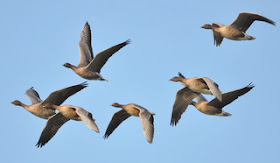I put up a new header photograph yesterday and the one above is another showing the stunning view from the top of Birk Bank, in the background are the Lakeland hills though distant and far from clear in this photograph, but if you see it for real it is pretty impressive. The header is one I took on a morning I was heading off to do the monthly observations at one of my most favourite of birding locations on Clougha and Birk Bank primarily to check out the Stonechats there. It was a brilliant morning and went on the be a brilliant day, the scene in the picture came into view as I reached the top of Quernmore Road and was breathtaking as can be seen in the header picture, I just had to take a photograph of this beautiful English countryside.
I've been going to this area on the fringe of the Forest of Bowland for almost twelve years now and the survey takes me anything up to five hours at a dawdle, I enjoy every minute of the visit which has kept me up to date on the status of the Stonechat in the area since I saw a distant bird here in 1999 when the Stonechat was certainly not a bird to be found on a daily basis, I thought at the time that I should give this area a good going over, and I'm still doing so. Although upland birding never creates a lengthy list of birds it has produced one or two bonus surprises over the years, the latest being two Spotted Flycatchers on 26 August and was a first record for me, this species certainly does not breed here and I was lucky to be at the right place at the right time to find these two off passage. I've also seen Honey Buzzard, Hen Harrier, Merlin, Short-eared Owl, and Hooded Crow to mention a few, it is also good for finding Whinchat off passage, another species which doesn't breed here anymore and has never done so in the twelve years I've been coming here though it has in the past.
I remember the walk to the summit of Clougha one summers evening with John Leedal, on reaching the top the view was stunning and JL told me how lucky I was in that it was one of those rare occasions when the panoramic view was at its best, with the mountains of the Lakes, Morecambe Bay, Blackpool Tower, Snowdonia in Wales, and the best and the rarest sight of all, the Isle of Man.
If you can appreciate the aesthetics combined with your birding you're on a winner, if you can't you're the looser.
Pink-footed Geese. Gary Jones.
I was doing another search through my records today, this time it was of neck collared Pink-footed Geese I've seen to date, I was reminded of some of the amazing movements of these birds when you read through their sheets of histories and chose this one to illustrate how one bird inexplicably moves from one place to the other whilst perhaps not being able to understand why it should want to do so. This bird was marked as an adult in 1999 at Nautalda, Thjorsarver, C.Iceland with the collar FLY and during the winter of 2004/05 through observations and collar readings made the following movements....
On 25 September FLY was at Loch Leven in Perth and Kinross.
In just under 4 weeks FLY was seen on 23 October in Holkam, Norfolk.
And 12 days later on 4 November FLY was back at Loch Leven in Perth and Kinross.
Another 16 days later FLY was back in Burnham Market in Norfolk on 20 November.
FLY was then seen 8 weeks later on 21 January at Martin Mere in Lancashire.
And on 11 March was back again at Dowhill, Perth and Kinross.
Pink-footed Geese may make much more amazing movements within the UK during the winter months than FLY did in this example, but did they really have to go to all that trouble and fly all that distance.
I'D SOONER BE BIRDING!
Another 16 days later FLY was back in Burnham Market in Norfolk on 20 November.
FLY was then seen 8 weeks later on 21 January at Martin Mere in Lancashire.
And on 11 March was back again at Dowhill, Perth and Kinross.
Pink-footed Geese may make much more amazing movements within the UK during the winter months than FLY did in this example, but did they really have to go to all that trouble and fly all that distance.
I'D SOONER BE BIRDING!


No comments:
Post a Comment